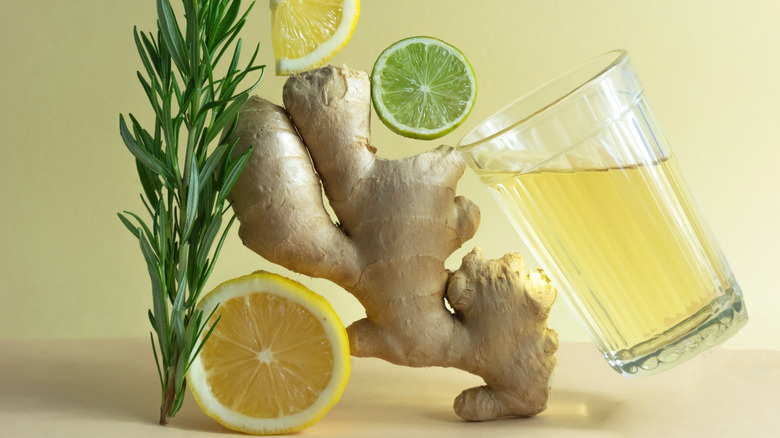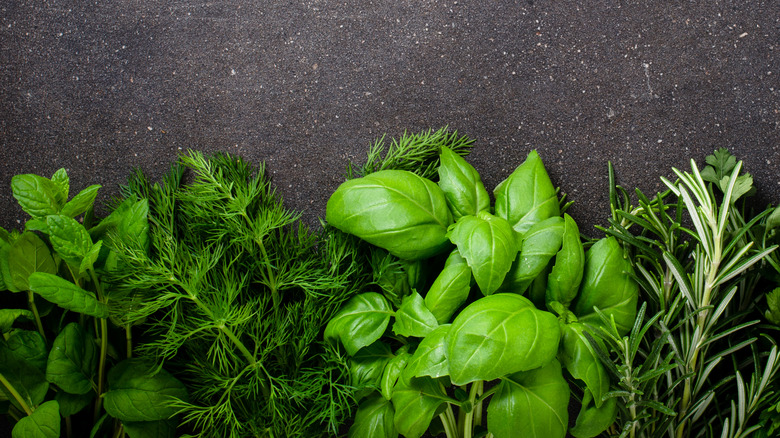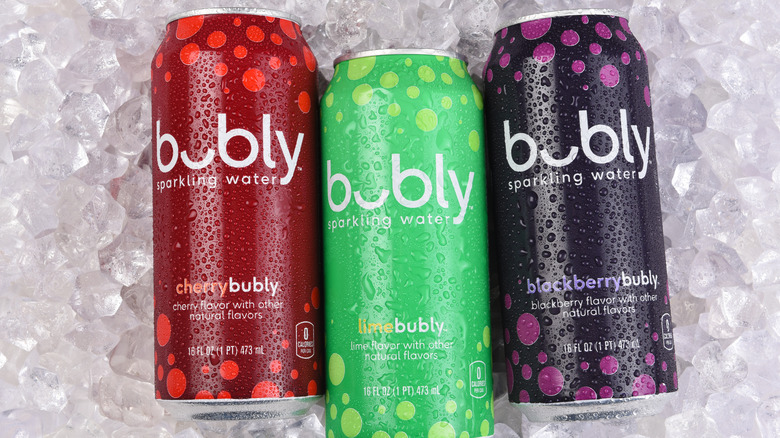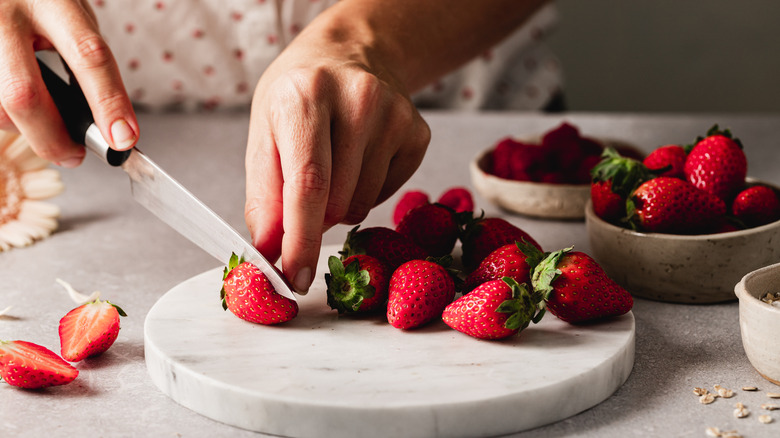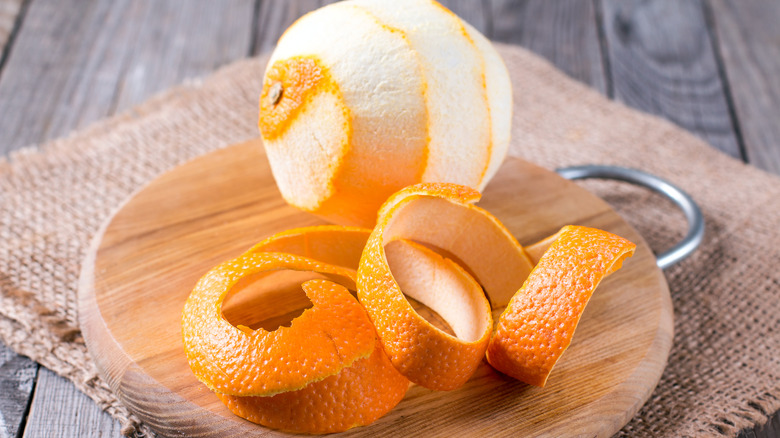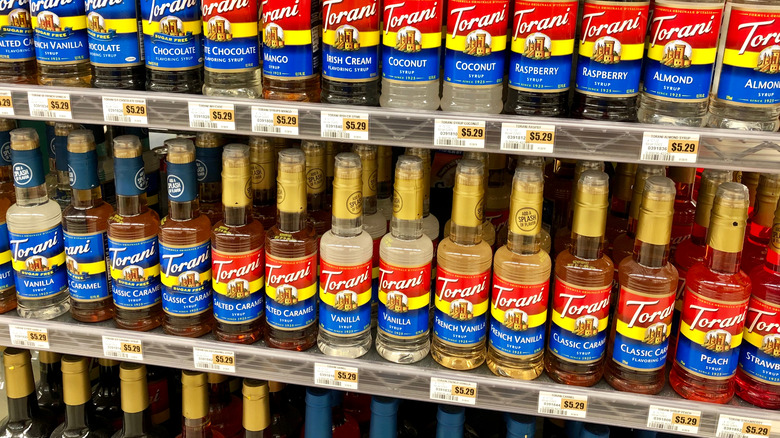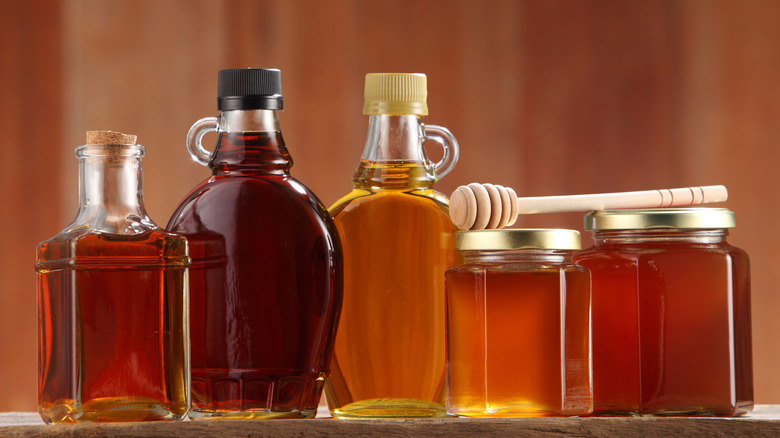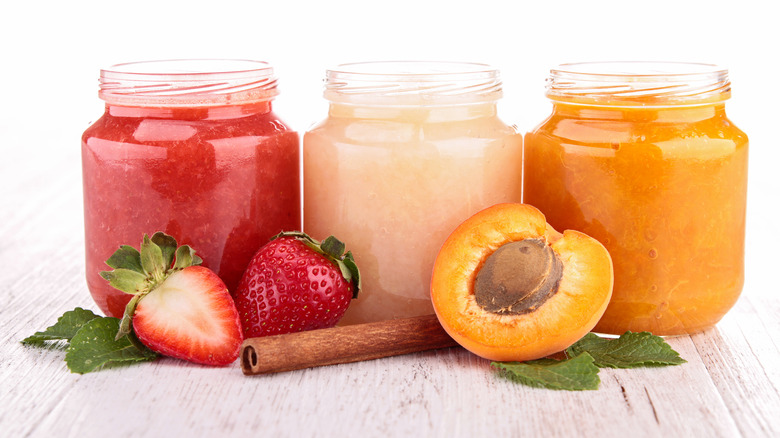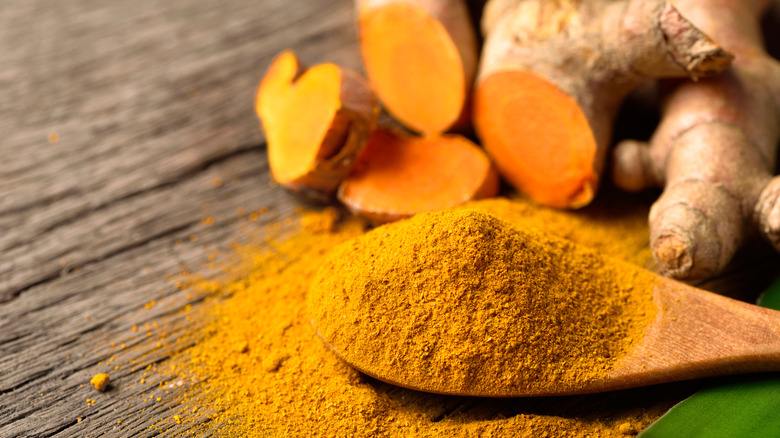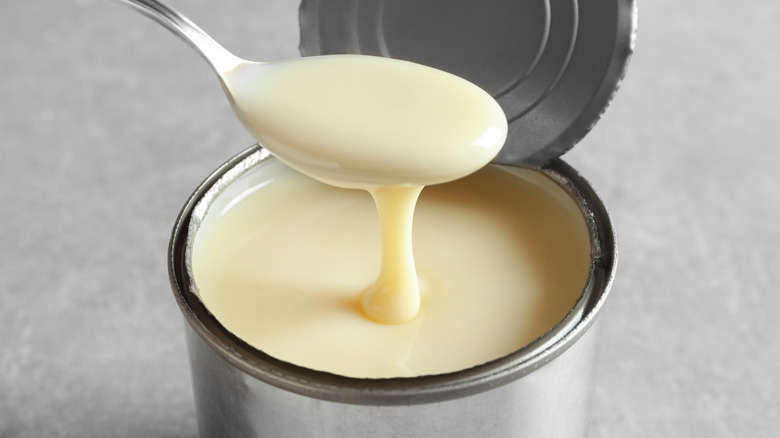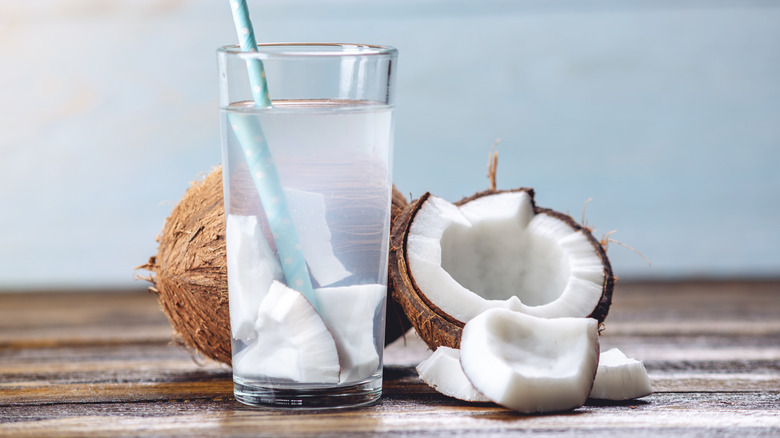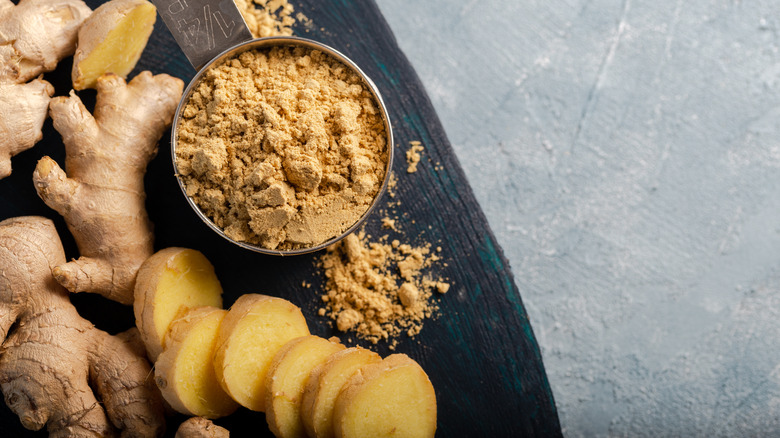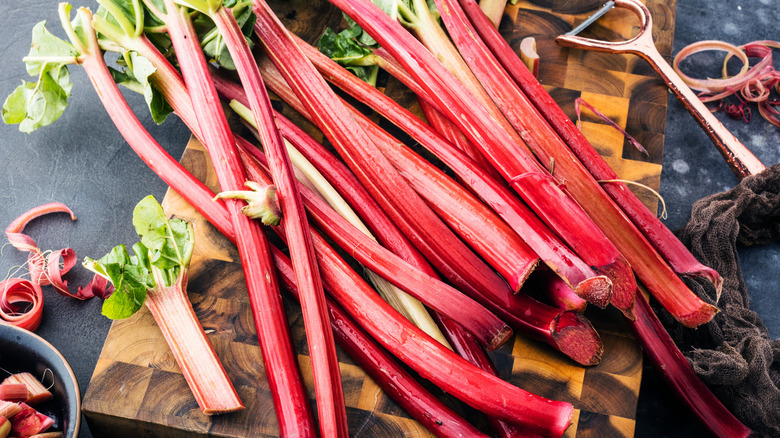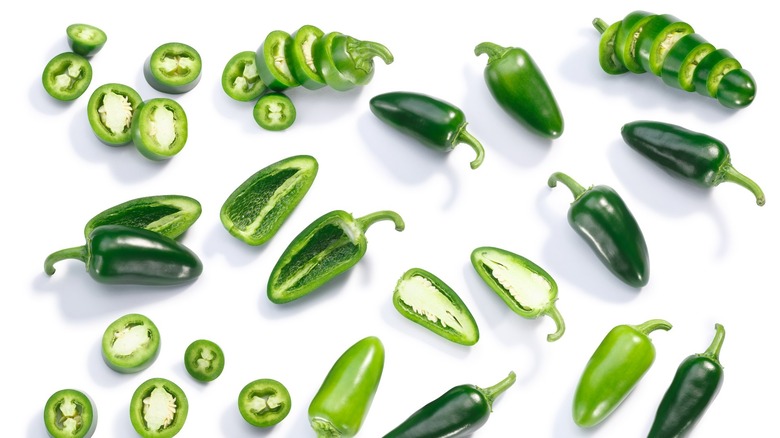14 Ingredients That Instantly Elevate Store-Bought Lemonade
There is nothing quite like treating yourself to a refreshing glass of ice-cold lemonade in the spring or summertime. The ideal lemonade has a harmony of tart and sugary qualities so that you can enjoy the citrusy flavor without having to pucker your lips too much in the process. However, some store-bought lemonades are too sugary, and others might be too sour for your liking. This isn't an issue, though; you can easily mix in other ingredients you have at home to improve the drink's balance and create the lemonade of your dreams.
Sometimes store-bought lemonades have the right taste, but you still want to dress them up and make them more gourmet. Whichever the case, there are plenty of garnishes and inclusions that make the beverage more sophisticated. So, whether you buy large jugs, single-portion cans, or lemonade mix to combine with water, there is no shame in buying the pre-made stuff; it can be just as special and tasty as if you squeeze the lemons by hand.
Fresh herbs
Fresh herbs brighten the drink and bring out the best qualities in the lemons. Several herbs upgrade lemonade, such as mint, thyme, rosemary, and basil; use the herbs for flavor and appearance. With fresh thyme, you can put a whole sprig inside the cup of lemonade, having it stand up past the glass' brim; this not only looks classy, but hints of earthiness in the drink. You can take the same approach with fresh rosemary, which looks divine in the lemonade with its long leaves.
If you use fresh basil, you don't need to chop it; you can submerge the leaves in the lemonade and then place some on top for garnish. Basil is known to be sweet and pairs wonderfully with the citrus in the drink. You can also steep the basil in sugar water to make an herb syrup that's stronger-tasting. Lastly, you can use fresh mint in the same fashion as you would basil; its sweet, yet cooling, taste is unmatched in an iced drink like lemonade.
Sparkling water
Give the lemonade some carbonation when you combine it with sparkling water. Plain sparkling water has a relatively neutral flavor, so you can use it to slightly dilute the lemonade if you feel it is too sugary or sour. On the other hand, if you desire the carbonation, but still want the beverage to be extra fruity, you can also experiment with different flavors. For example, use variations like watermelon, apple, cherry, and grape. And yes, there are lemon-flavored sparkling waters for the folks who want to stay loyal to the lemons.
Also, certain sparkling water brands take pride in their product's high mineral content, so you can intake some extra minerals while you stay hydrated. As you can see, when choosing which type of carbonated water to add to your lemonade, you are certainly not short on options. We recommend a ratio of 75% lemonade and 25% sparkling water, but you're welcome to adjust it to your preferences. Ultimately, any kind you pick makes the lemonade bubbly and light.
Fresh fruit pieces
If you've ever had Starbucks' Strawberry Açaí Lemonade, you likely appreciate the look of the strawberry pieces that they put into the drink; there is just something enticing about seeing fruit floating in an iced beverage when you're looking for something fruity to quench your thirst. You can include various fruits in your lemonade, which modifies the flavor, makes store-bought lemonade a bit fancier, and gives it that homemade feel. Tons of various berries pair with lemons, like blueberries, blackberries, raspberries, and strawberries. However, it doesn't stop there; other fruits that also work well include pineapple, mango, cucumber, and peaches.
Whether you choose to go with only one type of fruit or you want to make a mixed fruit lemonade, make sure not to chop the pieces too small, especially if you drink the lemonade with a straw. Moreover, be mindful of seeds, which can be a choking hazard, especially for children. Ultimately, the large fruit chunks are mainly for presentation purposes. However, if you desire that the flavors trickle into the lemonade, then mix the fruit into the drink and let the flavors marry in the refrigerator for a while before you drink it.
Citrus peels
If you want to boost the intensity of citrus in your lemonade, consider adding fresh citrus peels or zest. It doesn't have to be just lemons you use. You can also get creative and use oranges or limes, which provide a tangy, yet slightly different, taste. Remove the peels from the fruit and break it or chop it into pieces before you mix it into the lemonade; the chunky peels steal the show with their vibrant colors. Use multiple types of citrus fruits simultaneously to have a colorful, succulent drink. Alternatively, use a box grater or microplane zester to grate lemons.
Although you might not think that lemon zest would make a drastic difference in a drink that's already lemon-flavored, there is a trick that helps accentuate lemon zest's potency. If you rub granulated sugar and grated lemon peels in your hands together for a few minutes, it draws out the natural oils in the zest; this is where most of the flavor lies. Once you take this extra step and stir the zest into the beverage, the lemonade instantly tastes much fruitier and more vibrant.
Flavored syrups
Create fun lemonades when you include unique flavored syrups. Of course, you can use a syrup explicitly made for drinks, but dessert syrups also work just as efficiently. Some fruity syrup flavors that you can find include raspberry, mango, passion fruit, peach, watermelon, kiwi, and blood orange; you can even use multiple syrups at once. For instance, use passion fruit and coconut syrup to make a tropical lemonade. Or veer from the fruity syrups and try other kinds like vanilla, mint, or brown sugar.
Depending on the syrup, it might slightly alter the drink's color, but not dramatically because you don't need many pumps for the flavor to shine. Typically, the syrups taste very concentrated, so we advise you to use a small amount and taste the drink to see if you can taste it. From there, you can add more if you need to. The positive thing about these products is that they effortlessly blend into the drink and are ready to use, so it is a quick way to upgrade your tasty beverage.
Natural sweeteners
Some lemonade brands are quite tart, which many people enjoy, but sometimes you want a drink with more sweetness. Luckily, there are many ways to naturally sweeten the lemonade with things like maple syrup, honey, or agave nectar. If you ever add table sugar to an iced drink, it sometimes has trouble dissolving and stays grainy, sinking to the bottom. However, these sweeteners are beneficial because they are already liquid-like and have a deeper flavor than plain granulated sugar. There are many types of honey; wildflower honey, clover honey, and alfalfa honey are all outstanding options for when you sweeten your lemonade.
You can also use raw honey, which has the highest amount of nutrients since it doesn't go through a pasteurization process. The only drawback to this type of honey is that it often crystalizes, which makes it hard to mix into cold lemonade. When it comes to agave nectar, which is a sap from the agave plant, the darker variations taste caramel-like; this helps tone down the acidity in the lemonade when it is too strong for your liking. Of course, maple syrup's sweetness is much more prominent than agave, so if you put it in your lemonade, you need much less to get the job done.
Fruit juice or puree
One of the most decadent ways to supplement your lemonade with more flavor is to add fruit puree or juice. If you have fresh fruit, you can use a blender or food processor to transform it into a puree. Of course, it depends on the type of fruit, so make sure to wash it, peel it, and remove the pit if necessary. Next, chop the fruit into small segments and blend it until a paste forms; you might need to add water if it is too thick for the blade to run. It is up to you whether or not you want to strain seeds or pulp before you add it to the beverage.
Some types that taste wonderful in lemonade include cherry, watermelon, mango, raspberry, and strawberry purees. The lemonade changes color slightly depending on the fruit you use. Furthermore, you can customize the ratio of puree to lemonade. If you want a similar outcome, but don't have time to blend fruit, you can use store-bought fruit juices too. Namely, orange juice, cranberry, or peach juice all taste heavenly, and you can even combine multiple juices with lemonade to make unique concoctions.
Turmeric
If you want your lemonade to have an incredibly bright yellow hue, dissolve turmeric powder into the lemonade. If you've ever heard of golden milk, a beverage made with milk, turmeric, and other spices, you know how vivid turmeric is when you mix it into drinks. Although lemonade is already often yellow, it makes its color more profound and more appealing to the eyes. Concerning flavor, turmeric is earthy, but you only need such a small amount that its taste does not overpower the beverage. It has some spicy and bitter notes, but they pair well with the lemons' tart properties, and the drink's sweetness provides balance.
A bonus of turmeric powder is that it also has health benefits. Healthline states that one of its advantages is that it is known to be an anti-inflammatory food and prevents certain conditions, like cancer or heart disease, from developing. Turmeric powder is easier to use because you just need to add 1 or 2 teaspoons to the lemonade. Yet, if you want to use fresh turmeric, you need to peel, chop, and run it through a blender to create a paste that you can mix into the lemony drink.
Sweetened condensed milk
Citrus mixed with something creamy is assuredly an irresistible duo. One example of this combination would be orange creamsicle ice cream bars with zesty orange sherbet on the outside and creamy ice cream on the inside. While we are discussing lemons instead of oranges, the same concept applies when you mix velvety condensed milk into puckery lemonade. TikTok users often refer to this concoction as "creamy lemonade," which is quite valid. It is inspired by Brazilian lemonade, which has a similar makeup, except limes stand in place of the lemons.
You can add as much or as little sweetened condensed milk as you wish. The more you add, the less transparent the drink looks. Condensed milk tastes richer than regular milk and is thicker, so it doesn't water down the beverage. It also cuts down on acidity and makes the drink more dessert-like. Just make sure to stir it well because it takes a minute for the condensed milk to dissolve fully and become incorporated.
Coconut water
If the store-bought lemonade is too strong, dilute it with coconut water, which has more flavor than regular water. Coconut water is slightly sweet with salty undertones; although its flavor is mild, it is a perfect match for lemonade. Moreover, it has health benefits too, so it's a win-win. According to Healthline, coconut water is packed with electrolytes. Specifically, it contains magnesium and potassium, which ensure the body is hydrated, especially after you sweat; this is perfect for hot days when you're outside and grab your lemonade to satisfy your thirst because the coconut water makes it much more refreshing.
Additionally, Healthline reports that if you drink coconut water regularly, it might lessen the chances of you developing cardiovascular health problems; it also has a positive effect on blood pressure levels. So next time you need something to make your lemonade less potent, pour in a few splashes of flavorful coconut water.
Ginger
Did you know turmeric and ginger come from the same plant family? It is no wonder why they both taste so delightful in lemonade. Although they are botanically related, they each have their unique qualities. Ginger is not brightly colored like turmeric, so it doesn't change the drink's color. Furthermore, it is spicier and overall more pungent than turmeric. When you sip sweet, yet tart, lemonade, the ginger's spiciness hits the palate afterward, which creates a magical experience.
There are a couple of ways to include ginger in your beverage: fresh or food-grade ginger root extract. With fresh ginger, you must peel and grate it first. If you don't mind the pulpy feel, mix the tiny shreds directly into your drink. Alternatively, simmer the fresh ginger with water and sugar to create a syrup. Strain the ginger-infused liquid, allow it to cool, then mix it into the lemonade. The most effortless way to make lemonade have hints of ginger is to put drops of the extract into the drink and stir it in; you don't need much at all because the extract is robust.
Edible flowers
You likely had no idea about many edible flowers, and they are an optimal way to make your citrusy drink more elegant and delectable. Some flowers that work well in lemonade include hibiscuses, violets, roses, and lavender flowers. Of course, the flowers' appearance is essential, but their flavor is even more so because it infuses into the drink. So, if you want hints of tanginess, use hibiscuses, but if you want something sweeter, roses are the way to go (FYI, only the petals are edible with roses, not the whole flower).
While lavender has a charming scent and color, its raw leaves can have an unwelcoming aftertaste, even though they're initially sweet; use lavender buds in small amounts to avoid this. Regarding taste, violets are floral and sweet like roses but have their own distinct flavor. Bear in mind that the fresh flowers wilt when you submerge them, so we recommend you use them as both an addition to the ice and as a decoration for the top of the drink so that you can enjoy both their flavor and looks.
Rhubarb
Although rhubarb is a vegetable, it can be used similarly to fruits in lemonade because of its sweet and tart taste. One clever way to infuse rhubarb's flavor into your lemonade is to simmer it in water and sugar and allow it to steep, which creates a syrup. After you simmer it for roughly 20 minutes, strain it to remove the vegetable chunks so a colored liquid remains. Next, allow the syrup to cool before you stir it into the lemonade. This addition changes the beverage's color to a pink hue and makes it pleasantly tangy.
Another option is to make frozen lemonade with leftover strawberry rhubarb pie filling. Add the rhubarb mixture, lemonade, and ice to a blender and puree it until all of the elements combine; this works perfectly because the pie filling often has a few ingredients such as sugar, lemon juice, cooked strawberries, rhubarb, and sometimes cornstarch. However, the cornstarch amount is minuscule, so it isn't noticeable in the lemonade, and all other delicious ingredients take the spotlight.
Jalapeños
Quite literally spice up your lemonade with fresh jalapeños, and your beverage will be anything but boring. This inclusion is visible to the eye, and the peppers' fiery undertones pair perfectly with the drink's sweet and sour taste. The only downside to this addition is that it does require a couple of hours for the jalapeño flavor to seep into the liquid.
All you need to do is grab fresh jalapeños and rinse them. Then, slice them into coins or large enough pieces so they can't fit through a straw. Pour the pieces into the beverage, transfer the drink to the refrigerator, and then allow it to sit for at least two hours. Check on its flavor; mix the lemonade and peppers, then taste it to see if the spice level is where you want it. Of course, you can always let it sit longer if you prefer it to be spicier. However, the zesty beverage is scrumptious when the jalapeño taste is subtle.
